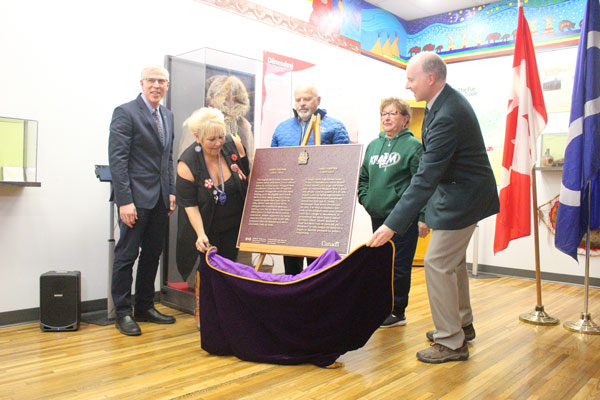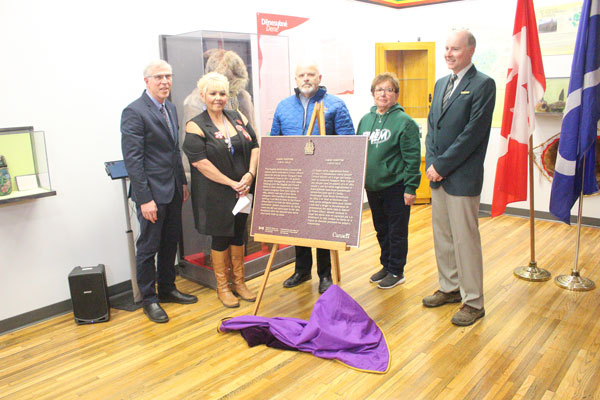
One of Prince Albert’s founding fathers was recognized with a special plaque unveiled at the Prince Albert Historical Museum on Tuesday.
The plaque commemorates the historical significance of English Métis leader James Isbister, a fur trader, farmer, and founder of the Isbister Métis Settlement that eventually became part of Prince Albert.
Representatives from Parks Canada and the Historic Sites and Monuments Board of Canada joined local residents for the unveiling. Sherry McLennan, the Director of Western Region II Métis Nation-Saskatchewan, said Isbister helped shape Canada’s shared history, and it was important to recognize that contribution.
“Today is an important day,” she said. “We are honouring James Isbister, a prominent leader in the Métis, who actually was the first person in Prince Albert to actually have come to Prince Albert…. We honour him today by this plaque that we are unveiling.”

The unveiling took place in Kistapinanihk/Omaniciye Makoca ‘The Gathering Place’ room, which will be holding a Grand Opening on Friday.
Isbister guided his people through the 1870s and 1880s and helped to unite English and French speaking Métis in their many attempts to have Canada recognize their land rights. He was one of four Métis delegates in 1884 who travelled to Montana to ask Louis Riel to return from exile to Canada in order to lead the Métis protest movement. Isbister supported the Métis cause but did not join in the Northwest Rebellion of 1885 after the Batoche-area Métis reluctantly took up arms.
After 1885, Isbsiter remained in Prince Albert where he farmed, engaged in Anglican parish life and taught Indigenous children on local reserves, including modern day Muskoday.
McLennan and members of the Isbister family have been advocating for this to take place for many years.
“I’m on the board as a knowledge keeper for the City of Prince Albert and this came up,” McLennan explained. “They wanted to know if we wanted to do this. We said, ‘yeah for sure we want push ahead with it.’ It is great recognition for a Métis leader that has been a part of our past. It talks about leaders and what they do in the Métis Nation. We are just very proud of Isbister.”
McLennan said many of Isbister’s relatives and descendants still live in the area today and are very proud of the mark their ancestor made on history. That includes Corinne Isbister, a member of the committee who married into the Isbister family.
The plaque ceremony had special meaning for McLennan, who grew up in the are near the Penitentary where Isbister homesteaded.
“I am and I have lived in Prince Albert all of my life, so I am pretty proud of Prince Albert,” she said. “Knowing that it was a Métis person who came here and started Prince Albert, and right in the heart of where I live, it makes me very proud.”
Isbister not only lived in the area. When he died, he was laid to rest at St. Mary’s church graveyard on the otherside of the penitentiary.
The University of Regina first recommended the Historic Sites and Monuments Board of Canada created a plaque to honour Isbister in 1996. That request was made on behalf of the James Isbister Memorial Fund.
An extensive consultation process with the Métis community followed, and the board was received letters supporting the designation from public leaders and academics.
McLennan explained that there are French and English speaking Métis as well as Cree speaking and they are trying to keep the languages alive.
“We have the different kinds of Métis across the land and we are trying to push for the language,” she said. “Right now language is huge. The Michif language, we want to incorporate it into the schools and we are doing that.”
For example, Saskatchewan Rivers School Division has introduced Michif language in both St. Louis and Prince Albert.
“It’s part of Truth and Reconcilliation calls to action so we are very proud of that,” McLennan said. “We want to ensure that the Métis people are proud of who they are. The Métis Nation are doing a lot of things to bring back the pride in the Métis people.”
The Master of Ceremonies was Historic Sites and Monuments Boards of Canada Board Member for Saskatchewan Bill Waiser. The Opening prayer was led by Métis Elder and Knowledge Keeper Effie Kuscnir and O Canada was performed by Barry Mihilewicz.
“The ceremony to recognize James Isbister is long awaited and we are pleased to officially recognize the National Historical Significance of James Isbister and install a plaque commemorating his place in history,” Waiser said.
The Government of Canada representative was Calvert Martin, Field Unit Superintendent of the Norther Prairie Field Unit of Parks Canada. McLennan was the speaker on behalf of the MN-S.
Mayor Greg Dionne spoke on behalf of the City of Prince Albert.
After the unveiling of the Plaque, Waiser read the text of the plaque in both English and French.
The reception and before the unveiling featured traditional Métis fiddle music by Donny Parenteau.
The plaque will be moved to a location near the Isbister homestead in the near future.
michael.oleksyn@paherald.sk.ca

